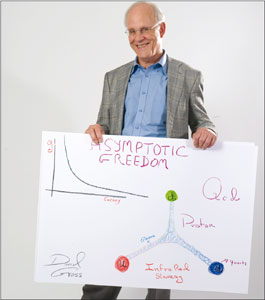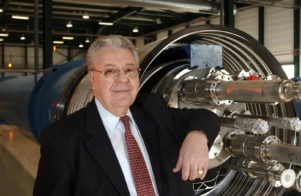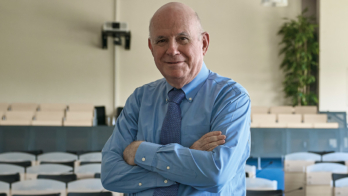
Image credit: V Steger.
When David Gross first came to CERN in the late 1960s, student protests across Europe, the Vietnam War and the Apollo Program were among the topics dominating world news. In particle physics the jury was still out as to the nature of quarks and the strong interaction, while not quite terra incognita, was hostile territory for theorists – full of wild and untamed beasts. In early 1969, Gross, who had recently taken up a faculty position at Princeton, and Chris Llewellyn Smith, a fellow in the theory division, worked together at CERN on a paper with the hot title of “High-energy neutrino–nucleon scattering, current algebra and partons”. In it, they laid down a sum rule that allowed the number of valence quarks in the proton to be measured with the neutrino beam and the Gargamelle bubble chamber at CERN (Gross and Llewellyn Smith 1969).
Today, the leading edge of research in particle theory, in its continuing search for a quantum field theory of gravity, treats fundamental objects not as the point-like partons of the Standard Model but as extended objects such as strings and membranes. The first ideas about string theory formulated in 1969, and it was strings that drew Gross back to CERN this summer. A key figure in the first “superstring revolution”, he is a member of the international advisory committee for the Strings conference series and he gave the outlook talk and a public presentation at Strings 2008 at CERN in August (CERN pulls Strings together).
Fond memories of CERN
Gross remembers his first visit to CERN as being an exciting time, especially in the theory division, which celebrated the publication of its 1000th paper during his stay. “CERN was the centre of theory,” he recalls, “unique in Europe, with lots of good young people.” He enjoyed his time a great deal, writing some six or so papers on various topics, including the Gross–Llewellyn Smith sum rule. He has since returned to CERN for several summer visits, with longer spells in 1974 and 1993, and he has had the opportunity to work with theorists such as Gabriele Veneziano, Julius Wess, Sheldon Glashow, Sidney Coleman, Gerardus ’t Hooft, John Bell&ellip;to name but a few.
Gross is now director of the Kavli Institute of Theoretical Physics (KITP) at the University of California, a position that he has held since 1997, after nearly 30 years at Princeton. He is best known for his major role in taming the dragons of the strong interaction in the 1970s. Some 40 years on from his first visit to CERN, quarks and the strong interaction are now part of the fundamental fabric of particle physics, and are well understood within the context of the Standard Model. They feature not only in high-school textbooks but also in magazines and TV programmes for the general public. The role that Gross played in establishing the theory of QCD as the pillar of the Standard Model that describes the behaviour of quarks and gluons – particularly his work with his student Franck Wilczek on asymptotic freedom in 1973 – was to lead to the Nobel Prize in Physics. He and Wilczek shared the prize in 2004 with David Politzer of Caltech, who arrived at the same conclusion independently – that strong interactions become weaker at shorter distances, allowing calculations within the context of perturbation theory.
It is not surprising that this is the work of which Gross remains most proud. “How inconceivable,” he says, “that we could actually have a theory, not just a phenomenology of strong interactions&ellip;it was mind-boggling that we did it.” He moved on to string theory in the early 1980s, when, he says, the “easy things” had been done in QCD. “Solving QCD seemed too hard; it was easier to look for a way to solve everything.” Ed Witten, another brilliant student who worked under Gross at Princeton, also joined the superstring revolution and became a leader in the field. “Ed developed an extraordinary skill in finding mathematical structures,” Gross recalls. “Trying to keep up with him was quite a challenge,” he admits, but adds that “it’s always good to be able to learn from your students.” He notes that, in particle physics today, “it’s amazing how mathematically educated young people are”.
Indeed, Gross sees this as a major shift in the field since he started out in theoretical particle physics in the 1960s. “The differences,” he says, “are like day and night. Experiment was king in 1969.” He describes working in theory then as “pretty miserable”, while the experimental side of things was constantly discovering “incredible surprises”. Then, in around 1970, the situation began to change, with a shift in experiments towards confirming the Standard Model. Prior to that, mathematics in particle physics was relatively primitive, but then along came input from mathematically talented young theorists who were extremely successful. This was “much to the chagrin of a generation or two of experimenters”, Gross smiles, and created a “generation of middle-aged theorists who didn’t know what the underlying theory was”.
What does he see now for the future of particle physics, particularly in light of the LHC start-up? He believes that it is a “safe bet” that experiments will confirm the Higgs mechanism, and a “good bet” that supersymmetry will be discovered. Beyond that, he says, the LHC is in the right energy region to deliver surprises, although he adds that the abandoned Superconducting Super Collider with its reach to 40 TeV in the centre of mass would have been better. The nightmare, in his view, will be if there are no surprises, which would leave the subject in “deep trouble”. It will be difficult in the absence of real clues from the LHC to argue the case for an expensive next stage. It could, he says, be like asking for “lots of money to go 1 km into a 100 km desert”.
In the past, the development of new accelerator techniques has often helped to keep down the cost of the advance into unexplored energy regions. “We need to stay on the Livingston plot,” Gross comments, in reference to the well known plot of the evolution of accelerators in energy. He notes that physicists working on space-based instruments face a similar problem.
Meanwhile, theoretical physicists remain relatively inexpensive, which allows them to continue to cover a broad scope of research. At KITP, Gross has been fortunate to build up a theoretical physics centre of the kind that he experienced at CERN as he was entering the field. With some 1000 visitors a year from around the world, the institute forms the basis of one “big family” and a stimulating environment for research. Particle physicists, there as elsewhere, are eagerly waiting for the LHC to reveal what nature has in store at higher energies – and, who knows, it may tip the balance back towards experiments again.
• For a video of the outlook talk by David Gross at Strings 2008, visit http://cdsweb.cern.ch/record/1121966?ln=en.
Further reading
David J Gross and C H Llewellyn Smith 1969 Nuc. Phys. B14 337.





